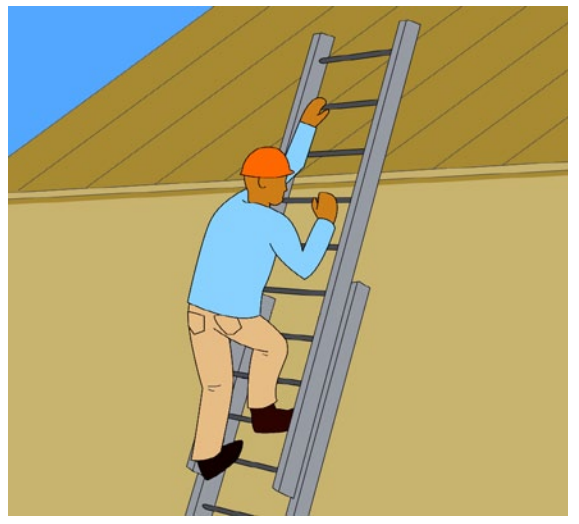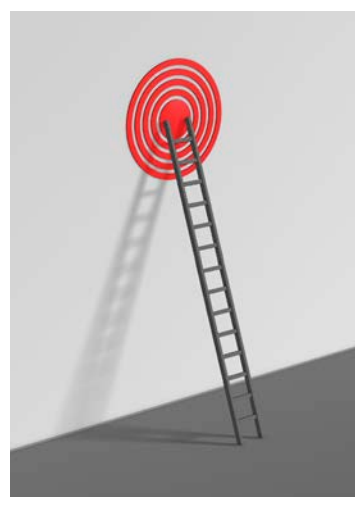Ladder Safety
Falls from portable ladders (step, straight, extension, and combination) are the leading cause of occupational fatalities and injuries. Ladder accidents are caused mainly by improper ladder selection or setup, overreaching / loss of balance, and slipping while climbing up or down.
Virtually every single ladder accident could and should have been prevented. It only takes a little bit of awareness, a commitment to safety and some common sense to prevent an accident from occurring while using ladders. Follow manufacture recommendations and stick to the following simple rules to ensure that you or your fellow workers are never injured while using a ladder.
This procedure outlines general information selection, inspection and use of portable ladders.
Safe Work Practices
Ladder Selection
The design and use of ladders must comply with all federal, state and local requirements including, but not limited to, the applicable portions of OSHA 29 CFR 1910.23 and/or 1926.1053.
Always ensure the ladder you are using is rated for your weight and any Personal Protective Equipment (PPE) and/or tool belts being worn. Type IA (300 lb. limit) ladders are recommended, with Type I (250 lb. limit) being the minimum allowed. In some cases, type IAA (375 lb. limit) may be the best option. Always select the right ladder.
Aluminum ladders must not be used where the employees or the ladder could come in contact to exposed energized parts, unless they have nonconductive side rails.
A step ladder must not be used as a straight ladder.
The use of job-made ladders is discouraged. However, if there is a practical need for a job-made ladder, the requirements in OSHA 1926.1053 (Ladders) shall be followed when constructing a job made ladder. In addition, all job-made ladders shall be approved by the Environmental, Health and Safety department prior to use.
Ladder Inspection
Ladders must always be in good condition. The user shall inspect the ladder from top to bottom before each use. Always check the following:
- Legible duty rating label that shows ladder type and rated capacity.
- Proper hardware (braces, rivets, spreader bars, rung locks, nuts, bolts, feet)
- Cracks in wood, metal
- Hairline stress cracks near rivet points on fiberglass ladders
- Rot
- Rigidity
- Splinters
- Loose, missing or broken steps
- Corrosion of hardware or metal rungs
- Dents or bends
- Broken, frayed or worn extension ladder ropes and pulleys
- Missing or damaged non-slip feet on all straight and extension ladders
- Inoperable extension devices
- Free of slippery material on rungs, steps or feet.
Damaged ladders must not be used and must be taken out of service immediately.
Storing and Transporting Ladders
Ladders are to be stored on racks or in approved storage areas. All ladders shall be stored in a secure position. All ladders shall be protected from the elements, with good ventilation, and away from excessive heat.
Do not put materials on stored ladders.
Properly support ladders being transported on motor vehicles. Supporting points should be made of material such as wood or rubber-covered iron pipe, to minimize chafing and the effects of road shock.
Ladder Setup
- Always place ladders stable and level surfaces unless it has been secured top and bottom to prevent displacement.
- Make sure that the ladder has firm footing and is not supported (top or bottom) on movable surfaces.
- Straight and extension ladders used to access roofs or platforms must extend at least 3 feet above the point of support.

- Step ladders are meant to be used as self-supporting ladders and must never be used in the closed position. If you are using a step ladder, make sure that it is fully open with both spreaders fully locked.
- Never place a ladder on boxes barrels or other unstable bases to obtain additional height.
- Ladders must not be placed in front of doors or door openings unless the door is blocked open, locked or guarded by a responsible person.
- Ladders used in hallways or traffic areas must be protected by barricades or cones.
- Ladders must be secured to keep them from shifting, slipping, being knocked over or blown over by the wind. Splice a rope to the top back rung of stepladders or to the third rung from the top of straight and extension ladders to provide a tie-off when the ladder is set up.
- Extension ladders must not be separated because this eliminates the safety feet from one section and can cause damage the pulleys and rung locks on the extension section.
- Only use ladders and appropriate accessories (ladder levelers, jacks or hooks) for their designed purposes.
- Make sure that the ladder’s feet are one-quarter the length of the ladder away from the upright surface to be climbed (4/1 rule).

- Consider using a spotter when using extension or straight ladders to work above 6 feet.
- Be sure that all locks on or extension ladders or properly engaged.
Climbing the Ladder
- Don’t carry tools or materials, raise and lower them with a hand line, don’t have someone toss them up to you or just drop them when you are finished.
- If you don’t feel well, don’t climb the ladder.
- Always maintain 3-points of contact (2 hands and a foot, or 2 feet and a hand) with the ladder at all times when climbing up or down.
- Keep your body near the middle of the step and always face the ladder while climbing.
- Never stand above the second step from the top cap of a stepladder.
- Never stand above the fourth rung from the top of an extension ladder.
- Personnel must always face the ladder and hold onto the ladder when ascending or descending.
- Two or more people are not permitted to work from the same ladder unless it is specifically designed for two people. Safety instructions should be given before employees use a two-person stepladder.
- Do not move or shift a ladder while a person or equipment is on the ladder.
When the Work is Complete
Ladders must be taken down, stowed and secured at the end of each work day.
Personal Protective Equipment (PPE)
Shoes worn while climbing a ladder shall be clean and slip resistant to prevent falls. Additional PPE shall be worn that protects the user from hazards that may be encountered during the task. For specific details regarding hazards and PPE, refer to the PPE section under Programs and Procedures on the Office of Environmental Health and Safety web page.
Training
Employees shall have received ladder safety training prior to using any ladder.
Conclusion
Always ask: Do you really need to use a ladder? Is there a safer way to get up to the work? Consider using a scaffold or aerial lift.
When in doubt, contact the Office of Environmental Health and Safety to develop a safe way to proceed with the work.
Your ladder is one of your most important tools. It is also one of your most unforgiving if misused or mistreated; so, use it safely and wisely.